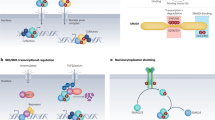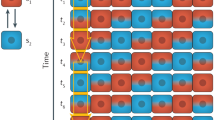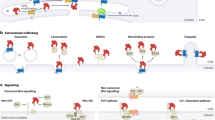Abstract
The intercellular communication that regulates cell fate during animal development must be precisely controlled to avoid dangerous errors. How is this achieved? Recent work has highlighted the importance of positive and negative feedback loops in the dynamic regulation of developmental signalling. These feedback interactions can impart precision, robustness and versatility to intercellular signals. Feedback failure can cause disease.
This is a preview of subscription content, access via your institution
Access options
Subscribe to this journal
Receive 51 print issues and online access
$199.00 per year
only $3.90 per issue
Buy this article
- Purchase on Springer Link
- Instant access to full article PDF
Prices may be subject to local taxes which are calculated during checkout








Similar content being viewed by others
References
Mayr, O. The origins of feedback control. Sci. Am. 223, 111–118 (1970).
Weiss, P. & Kavanau, J. L. A model of growth and control in mathematical terms. J. Gen. Physiol. 41, 1–47 (1957).
Turing, A. M. The chemical basis of morphogenesis. Philos. Trans. R. Soc. Lond. B 237, 37–72 ( 1952).
Gierer, A. & Meinhardt, H. A theory of biological pattern formation. Kybernetik 12, 30– 39 (1972).
Meinhardt, H. Biological pattern formation: new observations provide support for theoretical predictions. Bioessays 16, 627– 632 (1994).
Smolen, P., Baxter, D. A. & Byrne, J. H. Mathematical modeling of gene networks. Neuron 26, 567–580 ( 2000).
Liu, K. D., Gaffen, S. L. & Goldsmith, M. A. JAK/STAT signaling by cytokine receptors. Curr. Opin. Immunol. 10, 271–278 (1998).
Naka, T. et al. Structure and function of a new STAT-induced STAT inhibitor. Nature 387, 924–929 ( 1997).
Starr, R. et al. A family of cytokine-inducible inhibitors of signalling. Nature 387, 917–921 ( 1997).
Endo, T. A. et al. A new protein containing an SH2 domain that inhibits JAK kinases. Nature 387, 921–924 (1997).
Nicola, N. A. et al. Negative regulation of cytokine signalling by the SOCS proteins. Cold Spring Harbor Symp. Quant. Biol. 64, 397–404 (1999).
Kovanen, P. E. & Leonard, W. J. Cytokine signalling: Inhibitors keep cytokines in check. Curr. Biol. 9, R899–R902 (1999).
Marine, J. C. et al. SOCS1 deficiency causes a lymphocyte-dependent perinatal lethality. Cell 98, 609–616 (1999).
Alexander, W. S. et al. SOCS1 is a critical inhibitor of interferon gamma signaling and prevents the potentially fatal neonatal actions of this cytokine. Cell 98, 597–608 ( 1999).
Marine, J. C. et al. SOCS3 is essential in the regulation of fetal liver erythropoiesis. Cell 98, 617–627 (1999).
Bjorbaek, C., Elmquist, J. K., Frantz, J. D., Shoelson, S. E. & Flier, J. S. Identification of SOCS-3 as a potential mediator of central leptin resistance. Mol. Cell 1, 619–625 ( 1998).
Adams, T. E. et al. Growth hormone preferentially induces the rapid, transient expression of SOCS-3, a novel inhibitor of cytokine receptor signaling. J. Biol. Chem. 273, 1285–1287 (1998).
Ray, R. P. & Schüpbach, T. Intercellular signaling and the polarization of body axes during Drosophila oogenesis. Genes Dev. 10, 1711–1723 (1996).
Wasserman, J. D. & Freeman, M. An autoregulatory cascade of EGF receptor signalling patterns the Drosophila egg. Cell 95, 355–364 ( 1998).
Morata, G. & Garcia-Bellido, A. Wilhelm Roux Arch. Dev. Biol. 179, 125–143 ( 1976).
Bienz, M. & Tremml, G. Domain of Ultrabithorax expression in Drosophila visceral mesoderm from autoregulation and exclusion. Nature 333, 576–578 (1988).
Thuringer, F. & Bienz, M. Indirect autoregulation of a homeotic Drosophila gene mediated by extracellular signaling. Proc. Natl Acad. Sci. USA 90, 3899–3903 (1993).
Bienz, M. Heomeotic genes and positional signalling in the Drosophila viscera. Trends Genet. 10, 22–26 (1994).
Tremml, G. & Bienz, M. Induction of labial expression in the Drosophila endoderm: Response elements for dpp signalling and for autoregulation. Development 116, 447– 456 (1992).
Gonzalez-Reyes, A., Macias, A. & Morata, G. Autocatalysis and phenotypic expression of Drosophila homeotic gene Deformed: its dependence on polarity and homeotic gene function. Development 116, 1059– 1068 (1992).
McMahon, A. P., Joyner, A. L., Bradley, A. & McMahon, J. A. The midbrain-hindbrain phenotype of Wnt-1-/Wnt-1- mice results from stepwise deletion of engrailed-expressing cells by 9.5 days postcoitum. Cell 69, 581–595 ( 1992).
Heemskerk, J., DiNardo, S., Kostriken, R. & O'Farrell, P. H. Multiple modes of engrailed regulation in the progression towards cell fate determination. Nature 352, 404– 410 (1991).
Freeman, M., Klämbt, C., Goodman, C. S. & Rubin, G. M. The argos gene encodes a diffusible factor that regulates cell fate decisions in the Drosophila eye. Cell 69, 963–975 (1992).
Schweitzer, R., Howes, R., Smith, R., Shilo, B. -Z. & Freeman, M. Inhibition of Drosophila EGF receptor activation by the secreted protein Argos. Nature 376, 699–702 (1995).
Golembo, M., Schweitzer, R., Freeman, M. & Shilo, B. -Z. argos transcription is induced by the Drosophila EGF receptor pathway to form an inhibitory feedback loop. Development 122 , 223–230 (1996).
Freeman, M. Reiterative use of the EGF receptor triggers differentiation of all cell types in the Drosophila eye. Cell 87, 651 –660 (1996).
Freeman, M. Cell determination strategies in the Drosophila eye. Development 124, 261–270 ( 1997).
Perrimon, N. & McMahon, A. Negative feedback mechanisms and their roles during pattern formation. Cell 97, 13–16 (1999).
Ruohola-Baker, H. et al. Spatially localized rhomboid is required for establishment of the dorsal-ventral axis in Drosophila oogenesis. Cell 73, 953–965 ( 1993).
Golembo, M., Yarnitzky, T., Volk, T. & Shilo, B. Z. Vein expression is induced by the EGF receptor pathway to provide a positive feedback loop in patterning the Drosophila embryonic ventral ectoderm. Genes Dev. 13, 158–162 ( 1999).
Jin, M. H., Sawamoto, K., Ito, M. & Okano, H. The interaction between the Drosophila secreted protein argos and the epidermal growth factor receptor inhibits dimerization of the receptor and binding of secreted spitz to the receptor. Mol. Cell. Biol. 20, 2098–2107 (2000).
Casci, T., Vinós, J. & Freeman, M. Sprouty, an intracellular inhibitor of Ras signalling. Cell 96, 655–665 (1999).
Ghiglione, C. et al. The transmembrane molecule kekkon 1 acts in a feedback loop to negatively regulate the activity of the Drosophila EGF receptor during oogenesis. Cell 96, 847– 856 (1999).
Capdevila, J., Vogan, K. J., Tabin, C. J. & Izpisua Belmonte, J. C. Mechanisms of left-right determination in vertebrates. Cell 101, 9–21 (2000).
Schier, A. F. & Shen, M. M. Nodal signalling in vertebrate development. Nature 403, 385–389 (2000).
Nonaka, S. et al. Randomization of left-right asymmetry due to loss of nodal cilia generating leftward flow of extraembryonic fluid in mice lacking KIF3B motor protein. Cell 95, 829– 837 (1998).
Saijoh, Y. et al. Left-right asymmetric expression of lefty2 and nodal is induced by a signaling pathway that includes the transcription factor FAST2. Mol. Cell. 5, 35–47 ( 2000).
Gaio, U. et al. A role of the cryptic gene in the correct establishment of the left-right axis. Curr. Biol. 9, 1339– 1342 (1999).
Yan, Y. T. et al. Conserved requirement for EGF-CFC genes in vertebrate left-right axis formation. Genes Dev. 13, 2527– 2537 (1999).
Meno, C. et al. Mouse Lefty2 and zebrafish antivin are feedback inhibitors of nodal signaling during vertebrate gastrulation. Mol. Cell. 4, 287–298 (1999).
Rodriguez Esteban, C. et al. The novel Cer-like protein Caronte mediates the establishment of embryonic left–right asymmetry. Nature 401 , 243–251 (1999).
Yokouchi, Y., Vogan, K. J., Pearse, R. V. II & Tabin, C. J. Antagonistic signaling by Caronte, a novel Cerberus-related gene, establishes left-right asymmetric gene expression. Cell 98, 573–583 (1999).
Johnson, R. L. & Tabin, C. J. Molecular models for vertebrate limb development. Cell 90, 979–990 (1997).
Niswander, L., Jeffrey, S., Martin, G. R. & Tickle, C. A positive feedback loop coordinates growth and patterning in the vertebrate limb. Nature 371, 609–612 (1994).
Laufer, E., Nelson, C. E., Johnson, R. L., Morgan, B. A. & Tabin, C. Sonic hedgehog and Fgf-4 act through a signaling cascade and feedback loop to integrate growth and patterning of the developing limb bud. Cell 79, 993– 1003 (1994).
Zuniga, A., Haramis, A. P., McMahon, A. P. & Zeller, R. Signal relay by BMP antagonism controls the SHH/FGF4 feedback loop in vertebrate limb buds. Nature 401, 598– 602 (1999).
Moon, A. M., Boulet, A. M. & Capecchi, M. R. Normal limb development in conditional mutants of Fgf4. Development 127, 989– 996 (2000).
Basler, K. & Struhl, G. Compartment boundaries and the control of Drosophila limb pattern by hedgehog protein. Nature 368, 208–214 (1994).
Tabata, T. & Kornberg, T. B. Hedgehog is a signaling protein with a key role in patterning Drosophila imaginal discs. Cell 76, 89–102 ( 1994).
Zecca, M., Basler, K. & Struhl, G. Sequential organizing activities of engrailed, hedgehog and decapentaplegic in the Drosophila wing. Development 121, 2265–2278 ( 1995).
Hooper, J. E. & Scott, M. P. The Drosophila patched gene encodes a putative membrane protein required for segmental patterning. Cell 59, 751–765 ( 1989).
Ingham, P. W., Taylor, A. M. & Nakano, Y. Role of the Drosophila patched gene in positional signalling. Nature 353, 184– 187 (1991).
van den Heuvel, M. & Ingham, P. W. smoothened encodes a receptor-like serpentine protein required for hedgehog signalling. Nature 382, 547–551 (1996).
Alcedo, J., Ayzenzon, M., Von Ohlen, T., Noll, M. & Hooper, J. E. The Drosophila smoothened gene encodes a seven-pass membrane protein, a putative receptor for the hedgehog signal. Cell 86, 221–232 (1996).
Chen, Y. & Struhl, G. Dual roles for patched in sequestering and transducing Hedgehog. Cell 87, 553–563 (1996).
Marigo, V., Scott, M. P., Johnson, R. L., Goodrich, L. V. & Tabin, C. J. Conservation in hedgehog signaling: induction of a chicken patched homolog by Sonic hedgehog in the developing limb. Development 122, 1225– 1233 (1996).
Goodrich, L. V., Johnson, R. L., Milenkovic, L., McMahon, J. A. & Scott, M. P. Conservation of the hedgehog /patched signaling pathway from flies to mice: induction of a mouse patched gene by Hedgehog. Genes Dev. 10, 301–312 (1996).
Chuang, P. T. & McMahon, A. P. Vertebrate Hedgehog signalling modulated by induction of a Hedgehog-binding protein. Nature 397, 617–621 (1999).
Heldin, C. H., Miyazono, K. & ten Dijke, P. TGF-beta signalling from cell membrane to nucleus through SMAD proteins. Nature 390, 465– 471 (1997).
Christian, J. L. & Nakayama, T. Can’t get no SMADisfaction: Smad proteins as positive and negative regulators of TGF-β family signals. BioEssays 21, 382– 390 (1999).
Massague, J. TGF-β signal transduction. Annu. Rev. Biochem. 67, 753–791 (1998).
Hayashi, H. et al. The MAD-related protein Smad7 associates with the TGF-β receptor and functions as an antagonist of TGF-β signaling. Cell 89, 1165–1173 ( 1997).
Tsuneizumi, K. et al. Daughters against dpp modulates dpp organizing activity in Drosophila wing development. Nature 389, 627–631 (1997).
Nakao, A. et al. Identification of Smad7, a TGF-β-inducible antagonist of TGF-β signalling. Nature 389, 631– 635 (1997).
Imamura, T. et al. Smad6 inhibits signalling by the TGF-β superfamily. Nature 389, 622–626 ( 1997).
Kleeff, J. et al. The TGF-β signaling inhibitor Smad7 enhances tumorigenicity in pancreatic cancer. Oncogene 18, 5363– 5372 (1999).
Stroschein, S. L., Wang, W., Zhou, S., Zhou, Q. & Luo, K. Negative feedback regulation of TGF-β signaling by the SnoN oncoprotein. Science 286, 771–774 (1999).
Bhalla, U. S. & Iyengar, R. Emergent properties of networks of biological signaling pathways. Science 283, 381–387 (1999).
Becksei, A. & Serrano, L. Engineering stability in gene networks by autoregulation. Nature 405, 590– 593 (2000).
Levine, A. J. p53, the cellular gatekeeper for growth and division. Cell 88, 323–331 (1997).
Oren, M. Regulation of the p53 tumor suppressor protein. J. Biol. Chem. 274, 36031–36034 ( 1999).
Ashcroft, M. & Vousden, K. H. Regulation of p53 stability. Oncogene 18, 7637–7643 (1999).
Di Marco, E. et al. Autocrine interaction between TGF-α and the EGF-receptor: quantitative requirements for induction of the malignant phenotype. Oncogene 4, 831–838 ( 1989).
Sporn, M. B. & Todaro, G. J. Autocrine secretion and malignant transformation of cells. N. Engl. J. Med. 303, 878–880 (1980).
Waddington, C. H. Canalization of development and the inheritance of acquired characters. Nature 150, 563–565 ( 1942).
Wilkins, A. S. Canalization: a molecular genetic perspective. BioEssays 19, 257–262 (1997).
Golembo, M., Raz, E. & Shilo, B. Z. The Drosophila embryonic midline is the site of Spitz processing, and induces activation of the EGF receptor in the ventral ectoderm. Development 122, 3363– 3370 (1996).
Heitzler, P. & Simpson, P. The choice of cell fate in the epidermis of Drosophila. Cell 64, 1083– 1092 (1991).
Collier, J. R., Monk, N. A., Maini, P. K. & Lewis, J. H. Pattern formation by lateral inhibition with feedback: a mathematical model of delta-notch intercellular signalling. J. Theor. Biol. 183, 429–446 (1996).
Acknowledgements
I am grateful to M. Bienz, T. Casci and S. Munro for their help with the manuscript.
Author information
Authors and Affiliations
Rights and permissions
About this article
Cite this article
Freeman, M. Feedback control of intercellular signalling in development. Nature 408, 313–319 (2000). https://doi.org/10.1038/35042500
Issue Date:
DOI: https://doi.org/10.1038/35042500
This article is cited by
-
Active droploids
Nature Communications (2021)
-
LncRNA TINCR favors tumorigenesis via STAT3–TINCR–EGFR-feedback loop by recruiting DNMT1 and acting as a competing endogenous RNA in human breast cancer
Cell Death & Disease (2021)
-
Genetic circuits to engineer tissues with alternative functions
Journal of Biological Engineering (2019)
-
Improvement of the memory function of a mutual repression network in a stochastic environment by negative autoregulation
BMC Bioinformatics (2019)
-
DNA-based communication in populations of synthetic protocells
Nature Nanotechnology (2019)
Comments
By submitting a comment you agree to abide by our Terms and Community Guidelines. If you find something abusive or that does not comply with our terms or guidelines please flag it as inappropriate.



